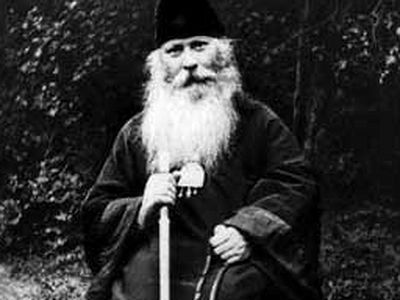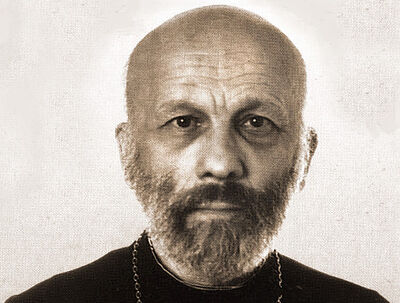Hieromonk Athanasius (Deryugin)Athanasius (Deryugin), Hieromonk
“>Hieromonk Athanasius (Deryugin) from Moscow’s Sretensky Monastery has answered some questions related to the Divine Liturgy.
 Hieromonk Athanasius (Deryugin)
Hieromonk Athanasius (Deryugin)
—Father Athanasius, your blessing.  In Memoriam: Metropolitan Amfilohije (Radovic; † October 30, 2020). Part 1He spoke from his own experience, and knew what works. Everyone wanted to get to know him and talk to him. And he was very approachable.
In Memoriam: Metropolitan Amfilohije (Radovic; † October 30, 2020). Part 1He spoke from his own experience, and knew what works. Everyone wanted to get to know him and talk to him. And he was very approachable.
“>Metropolitan Amfilohije (Radovic) said in an interview: “He who knows what the Liturgy is, knows what the Church is.” Please explain to us what the Liturgy is.
—If we give a formal definition, the Liturgy is a service during which, through the prayer of the priest and the whole Church, bread and wine become the Body and Blood of Christ and are administered to the faithful as Holy Communion. Speaking in essence, the Lord said that the unity of the Church is the unity of the Body of Christ: That they all may be one; as Thou, Father, art in Me, and I in Thee, that they also may be one in us (Jn. 17:21). And this unity is attained through our union in Christ and with Christ in Holy Communion. That is why participation in the Liturgy and awareness of what the Liturgy and Communion of the Body and Blood of Christ are, makes us belong to the Church of Christ.
—Please explain the meaning of what happens at the Liturgy.
—If we talk about a certain order of the Liturgy, the proskomedia is performed before it. At this time bread and wine are prepared to become the Body and Blood of Christ later. And then the main part of the Liturgy begins, which, in turn, consists of several parts: the singing of antiphons and troparia, the reading of the Holy Scriptures and the transfer of the Holy Gifts from the table of oblation to the altar table. There are other moments in the Liturgy as well, but the most important ones are the Eucharistic prayer and the transformation of the bread and wine into the Body and Blood of Christ. In fact, this is the central part of the Liturgy. In the Church it is called the Anaphora, and the laity sometimes call it the Eucharistic Canon. During this part of the Liturgy, the bread and wine, through the prayers of the priest and the whole Church, become the Body and Blood of Christ.
—When a Christian is present at the Liturgy, where should he direct his attention?
—As with any other church service, all attention should be focused on the texts that we sing and read in church. These texts are aimed at common prayer, therefore all of them, and especially the texts of the Liturgy, were not written in the singular, but in the plural—that is, this is not a call to personal prayer, but to the public prayer of the whole Church.

And the whole Liturgy attunes us for such public prayer. At litanies it is a prayer for the whole world, for the Church, for some of our personal needs, but in a communal sense. It is giving praise to God during the singing of antiphons; it is extolling a feast or saints during the singing of troparia. Our attention should be focused on every liturgical text. This applies to any church service, but especially to the Liturgy.
—Should a Christian attune himself inwardly when he is preparing to go to the Liturgy?
—First of all, it should be noted that the norm for a Orthodox Christian is to take Communion at every Liturgy he attends. This high standard was recorded in Church rules and can be found in writings of the early saints. Although now not every Christian is capable of this, and hardly any priest will demand it from everybody. But it is very important to remember that this is an ideal, that it is right, that it educates us first of all. And if we take Communion at the Liturgy, we must prepare for it properly. The entire Liturgy tells us about this. We hear the call: “Take, eat…”, “Drink of this, all of you…”, “With the fear of God, faith, and love, draw near…” Naturally, if the Church calls to us in this way, we must answer this call accordingly and take Communion. Clearly, it is impossible without some preparation, and, of course, no one will demand it from every Christian. But we must remember this ideal.
In any case, participation in the Liturgy, even if just prayerful (although, once again, this is not very correct), requires our attention. How can we concentrate on the Liturgy? There are different methods that the Holy Fathers suggest to us. For instance, many saints advise us to come to services in advance—that is, not just before their beginning—and certainly not to be late, in order to spend a little time in church in silence, in peace, and attune ourselves to prayer. A Christian who does this will see how differently, how much more deeply prayer is performed in this case at the Liturgy and at any other service!
—If a Christian is not going to take Communion at the Liturgy, should he nevertheless come to this service?
—It is better to discuss this question with your father-confessor. If we take St. Alexei Mechev of Moscow, he blessed some to receive Communion almost every day, but blessed others to do it once a week or once a month, because he was a practical pastor and understood what was more useful to each individual parishioner. There are no strict limits within which you are supposed to do it. Surely, even our prayerful participation is of some benefit to us. But the frequency of Communion and the depth of your participation in the Liturgy should be discussed with your father-confessor.
—Can we live a spiritual life without the Eucharist or taking Communion rarely?
—Traditions have varied in the Church at different periods. For example, in the eighteenth and the nineteenth centuries in the Russian Empire people received Communion very seldom. It was a generally accepted Church tradition. This was absolutely wrong. We can speculate much as to why it developed at that time, but the people who then adhered to the general tradition were probably not devoid of spiritual Christian life.
However, if we look at works of the saints and their life experience, we will see a call to take Communion as often as possible. We will see a call to live a permanent Eucharistic life. St. Basil the Great wrote: “It is good and useful for a layman to receive Communion every day. However, we receive Communion four times a week.” And these words were not addressed to some ascetics or hermits, but to ordinary Christians of his age. In the early Church it was indeed the norm.

We find calls for frequent Communion in the writings of  St. John of KronstadtSt. John of Kronstadt
St. John of KronstadtSt. John of Kronstadt
“>St. John of Kronstadt and many other saints who lived not so long ago. And now, thank God, the tradition of frequent Communion is being revived in the Church. And it is very good and right. I repeat: the question of how often a particular person should take Communion should be discussed with his father-confessor. Not all recommendations will be equally useful to different people. Anyway, we must remember that the ideal is frequent Communion.
—If a Christian takes Communion often, he can get used to it and may lose reverence. How can we inspire ourselves to perceive church services anew every time?
—It is very hard to talk about such subjects, because it is very individual for every person. In general terms, I can say that it is very good to “get used” to Communion, but in the right sense of the word. Not in the sense of perceiving it as something ordinary, but in the sense of making it your life. Just as we are used to eating and sleeping, so Communion should be vital to us. We should have this habit in the good sense of the word.
When it comes to loss of reverence, perhaps the main way to avoid this is to constantly meditate on the sacrament and the Liturgy. We very often lose reverence not only for Communion, but also for the church, worship, and prayer. This happens precisely because we do not reflect, do not remember what it means. When we enter the church, we do not remember that the Lord is present there. Standing at the Liturgy, we do not remember that what we are participating in is the most important thing in the universe. The universe exists because the Liturgy is celebrated. If we meditate on it, if we remind ourselves about it and sometimes even force ourselves to think about it, then frequent Communion will not be to our condemnation, but the contrary, to our benefit. And our habit of frequent Communion will be proper and necessary.
—What should the faithful pray for during the Anaphora?
—It is the moment when the whole Church prays for the bread and wine to become the Body and Blood of Christ. We should pray for this too. But, in addition, at this moment we can and even should remember people close to us, praying for their health and eternal rest, while “It is meet and right…” is being sung. At the same time, the priest in the sanctuary prays for people’s health and repose. And it will be useful for everyone praying in church to remember all those close to us, all those who need our prayers, so that this Liturgy will be truly universal, embracing not only those present at it, but also those for whom we want to pray.
—What should we do with the distraction of the mind at services? How can we not get distracted by extraneous things?
—There is only one answer here: to refocus your mind all the time. It gets distracted? Focus. It starts wandering again—focus again. Say in your mind: “Lord, forgive me my distraction”, and return to prayer. There are some methods that can help us keep the mind from wandering. There are many of them, and they are quite individual. We can find them by reading the Holy Fathers.

I have already mentioned that it is very important to come to services in advance and attune yourself in this way. There is another method: to stand at services with your eyes closed. Sometimes it helps, because we very often get distracted when we look to the right, then to the left and start thinking about something else.
The saints would give the following advice: Prepare in advance before the service. For example, all the texts of the Liturgy are more or less known.  Theophan the Recluse
Theophan the Recluse
“>St. Theophan the Recluse advises us to reread the texts of the service at home in advance and understand what thoughts should be born in us at this time. It is also advisable to read the explanations to the service in order to understand it better and understand what happens during it. And then these texts will become closer and more familiar to us, and they can bring us much more benefit during services. There are other methods as well. But the main principle is to focus the mind all the time. If we train ourselves, we will be able to acquire the good habit of concentration.
—What literature would you recommend to those who wish to understand this service more profoundly?
—Literature on this topic abounds. I have already mentioned that it is very important to know the text of the Liturgy and read its translation into a modern language. Of course, I can’t help but mention Homilies on the Divine Liturgy by the  Holy Hieromartyr Seraphim (Zvezdinsky)13/26 August is the commemoration day of Holy Hieromartyr Seraphim (Zvezdinsky), Bishop of Dimitriovsk and one of the most famous saints of the Russia Orthodox Church of the twentieth century.
Holy Hieromartyr Seraphim (Zvezdinsky)13/26 August is the commemoration day of Holy Hieromartyr Seraphim (Zvezdinsky), Bishop of Dimitriovsk and one of the most famous saints of the Russia Orthodox Church of the twentieth century.
“>New Hieromartyr Seraphim (Zvezdinsky). He loved and knew the service well, and wrote about it very loftily. Through this book we can also get some idea of his love and knowledge.
—Please tell us more about how the New Martyrs celebrated the Liturgy.
—When times of persecution come, it is not uncommon for many external aspects of the life of the Church to fade into the background. Then it becomes clear what is important and what is secondary. Our worship is very full, and with the right attitude these external moments help us get attuned to it. However, there are situations when not everything that is external can be performed, especially during persecution, and then only the main things remain.
For instance, in the Soviet era imprisoned clergy would have nowhere to get liturgical prosphora and wine, so they would celebrate the Liturgy on rye bread and cranberry or beet juice. They couldn’t always arrange the altar properly. Thus, the Liturgy could be celebrated anywhere—in a prison cell or elsewhere. Church vessels that the New Martyrs made for themselves from improvised materials and painted have been preserved; antimensions, which they [the bishops] signed, have survived as well. At the museum dedicated to the memory of the  Hiero-confessor Athanasius (Sakharov), bishop of KovrovOnce, in answer to the question ”How can one be saved?” he answered, ”The main thing is faith. Without faith, the very best of works are not unto salvation, for at the foundation of everything is faith. The second thing is repentance. The third is prayer, the fourth, good works. And despair is the worst of sins.” Vladyka advised, ”As soon as you are conscious of having sinned, cleanse your soul with tears.”
Hiero-confessor Athanasius (Sakharov), bishop of KovrovOnce, in answer to the question ”How can one be saved?” he answered, ”The main thing is faith. Without faith, the very best of works are not unto salvation, for at the foundation of everything is faith. The second thing is repentance. The third is prayer, the fourth, good works. And despair is the worst of sins.” Vladyka advised, ”As soon as you are conscious of having sinned, cleanse your soul with tears.”
“>New Hiero-Confessor Athanasius (Sakharov), Bishop of Kovrov, in the town of Petushki (the Vladimir region), the altar table, which he made from boxes, has been preserved as well.
Thus, our saints strove to ensure that the Liturgy never ceased, even when there were a minimum of possible external conditions for this. It is very interesting to read about how services were celebrated in the Solovki labor camp. For some time, the Soviet authorities allowed prisoners to serve in one of the churches there. When it was forbidden, the prisoners began to gather in a clearing, which they referred to as the “Cathedral of the Holy Trinity”, celebrating the Liturgy on a stump.

Of course, throughout the history of the Church, there have always been special conditions for worship. This applies not only to the era of the New Martyrs between the 1920s and the 1940s. In the 1970s and the 1980s, a secret priest,  A Secret Priest, a True Christian. Part 1Gleb Alexandrovich often came to see Vladyka. Naturally, we had no idea that the professor was a secret priest.
A Secret Priest, a True Christian. Part 1Gleb Alexandrovich often came to see Vladyka. Naturally, we had no idea that the professor was a secret priest.
“>Father Gleb Kaleda, who was a professor of geology, performed his ministry in Moscow. There are still memories of how those services were held. On Sundays Father Gleb and his whole family would get up very early. His vestments for worship were resewn every time, because secrecy was needed. They were then unstitched and laid out among the rest of the clothes so that no one would be suspicious if a search took place. Somewhere on the top shelf was a wineglass that served as a chalice. The TV was turned up loud in one room, and the radio—in another, so that none of the neighbors could hear what was going on. The service was performed in a room with curtained off windows and in a low voice. In such conditions, services were celebrated even at a relatively recent time. And it is very important to remember this, because we never know what times await our Church. We have to understand how it can be, what is important and what is secondary. It is vital to know this experience of the persecuted Church.